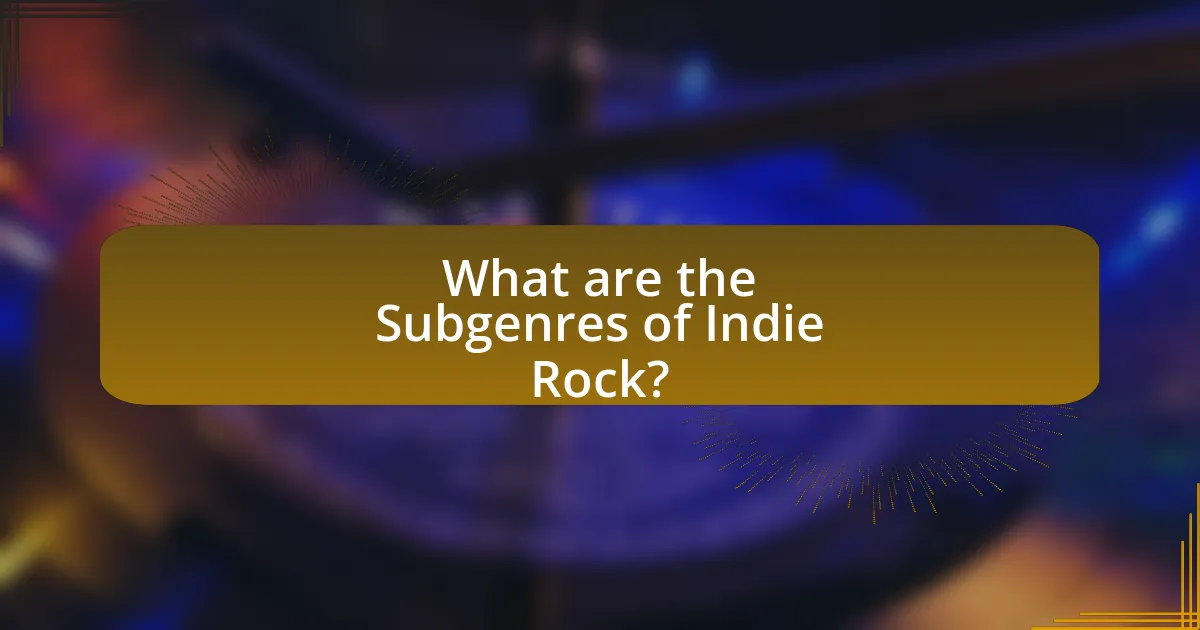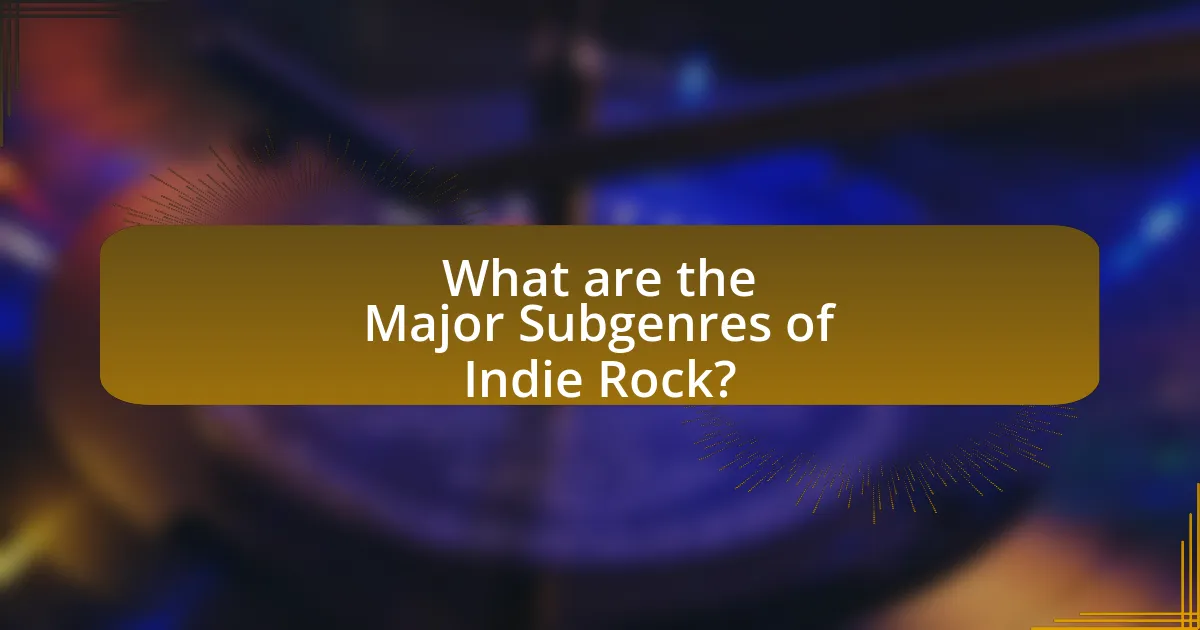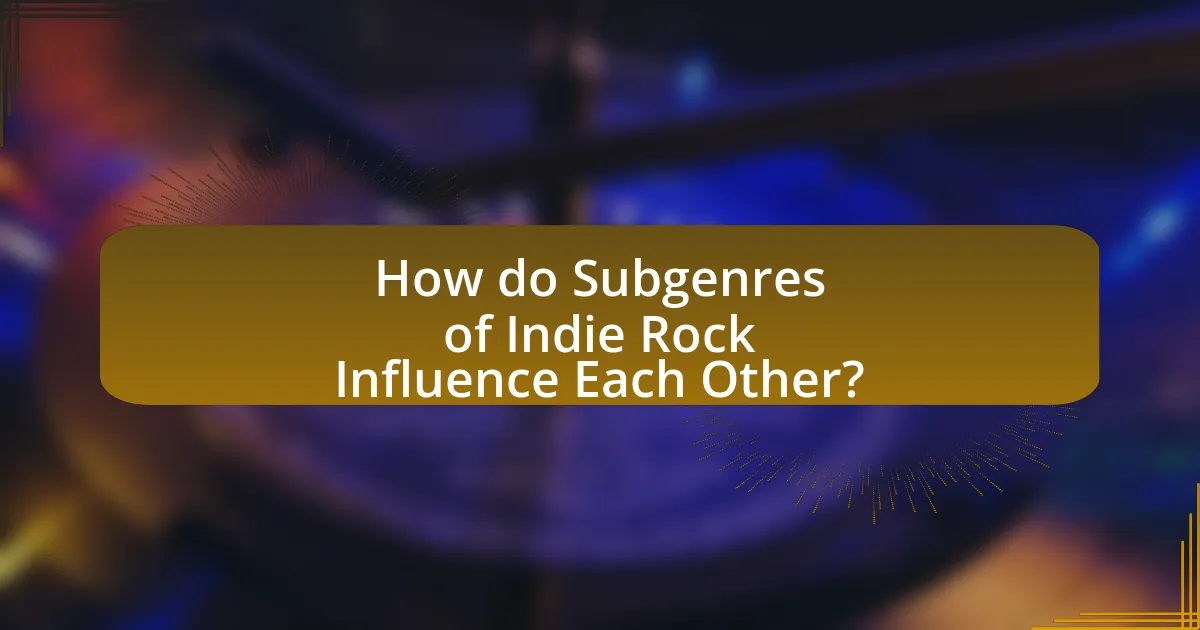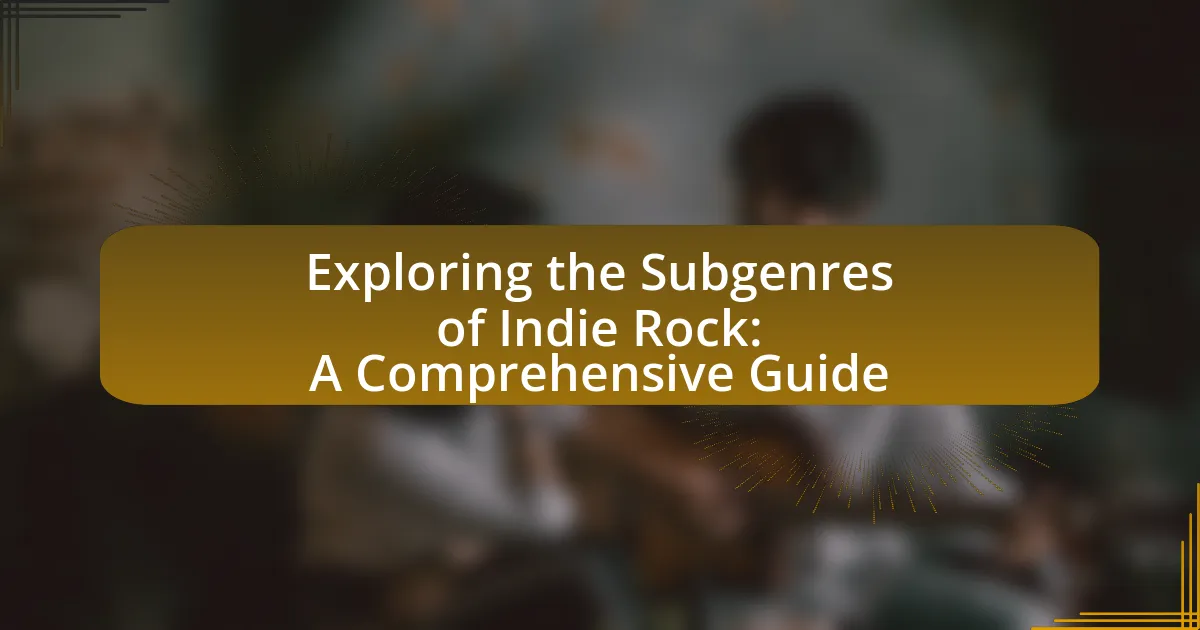The article “Exploring the Subgenres of Indie Rock: A Comprehensive Guide” provides an in-depth examination of the various subgenres within the indie rock genre, including lo-fi, dream pop, post-rock, and indie pop. It discusses the evolution of indie rock into these subgenres, highlighting historical factors such as the rise of independent record labels and the impact of the internet. The article also explores how cultural influences shape these subgenres, their defining characteristics, and the common lyrical themes present across them. Additionally, it addresses the interplay between different subgenres, the significance of alternative rock, and the role of indie pop and indie folk in the broader indie rock landscape. Finally, it offers insights into discovering new subgenres and resources for further exploration.

What are the Subgenres of Indie Rock?
The subgenres of indie rock include lo-fi, dream pop, post-rock, and math rock. Lo-fi is characterized by its raw sound and DIY aesthetic, often featuring unpolished production techniques. Dream pop emphasizes atmospheric soundscapes and ethereal vocals, creating a dreamy listening experience. Post-rock focuses on instrumental compositions and often incorporates elements from various genres, leading to expansive soundscapes. Math rock is known for its complex time signatures and intricate guitar work, appealing to listeners who appreciate technical musicianship. Each of these subgenres contributes to the diverse landscape of indie rock, showcasing its evolution and variety.
How did Indie Rock evolve into various subgenres?
Indie Rock evolved into various subgenres primarily through the diversification of musical influences and the emergence of distinct regional scenes. Initially rooted in the DIY ethos of the 1980s, Indie Rock began to incorporate elements from genres such as punk, folk, and electronic music, leading to the development of subgenres like Indie Pop, Post-Rock, and Lo-Fi. The rise of the internet in the 1990s facilitated the sharing of music across borders, allowing artists to experiment with different sounds and styles, which further contributed to the proliferation of subgenres. For instance, bands like The Shins and Death Cab for Cutie popularized Indie Pop, while groups like Sigur Rós and Explosions in the Sky defined Post-Rock with their atmospheric soundscapes. This evolution reflects a broader trend in music where genre boundaries became increasingly fluid, allowing for a rich tapestry of sounds within the Indie Rock umbrella.
What historical factors contributed to the emergence of Indie Rock subgenres?
The emergence of Indie Rock subgenres was significantly influenced by the rise of independent record labels and the DIY ethos of the 1980s and 1990s. Independent labels like SST Records and Sub Pop provided platforms for artists to release music outside of the mainstream music industry, fostering diverse sounds and styles. This environment encouraged experimentation and the blending of genres, leading to the development of subgenres such as lo-fi, post-rock, and emo. Additionally, the advent of the internet in the late 1990s and early 2000s allowed for greater distribution and discovery of Indie music, further diversifying the landscape and enabling niche subgenres to flourish.
How do cultural influences shape different Indie Rock subgenres?
Cultural influences shape different Indie Rock subgenres by infusing distinct regional sounds, themes, and aesthetics into the music. For instance, the lo-fi subgenre often reflects a DIY ethos prevalent in underground scenes, influenced by the punk movement and local cultural narratives. Similarly, the folk-rock subgenre incorporates traditional folk elements, often drawing from the cultural heritage of specific regions, such as the Appalachian influences in American folk-rock. Additionally, the emergence of subgenres like shoegaze showcases the impact of British cultural trends in the late 1980s, characterized by ethereal soundscapes and introspective lyrics. These examples illustrate how cultural contexts inform the evolution and characteristics of various Indie Rock subgenres.
What are the defining characteristics of Indie Rock subgenres?
Indie Rock subgenres are characterized by their diverse sound, often blending elements from various musical styles while maintaining an independent ethos. Key characteristics include a focus on artistic expression over commercial appeal, a DIY (do-it-yourself) approach to production and distribution, and a tendency to experiment with unconventional song structures and instrumentation. For instance, subgenres like Indie Pop emphasize catchy melodies and upbeat rhythms, while Indie Folk incorporates acoustic instruments and introspective lyrics. Additionally, genres such as Shoegaze are known for their ethereal soundscapes and heavy use of reverb, showcasing the wide-ranging influences within the Indie Rock umbrella.
How do musical elements differentiate each subgenre?
Musical elements differentiate each subgenre of indie rock through variations in instrumentation, tempo, melody, and lyrical themes. For instance, lo-fi indie rock often employs raw, unpolished sound with minimal production, while orchestral indie rock incorporates strings and brass for a fuller sound. Additionally, tempo can vary significantly; post-rock subgenres may feature slow, atmospheric builds, contrasting with the upbeat rhythms found in indie pop. Melodic structures also differ, with some subgenres favoring complex harmonies, as seen in math rock, while others may lean towards straightforward, catchy hooks typical of indie pop. Lyrical themes further distinguish subgenres, with some focusing on introspective narratives common in folk-influenced indie, while others may explore abstract or surreal concepts prevalent in experimental indie. These specific musical elements create distinct identities for each subgenre within the broader indie rock category.
What lyrical themes are common across various Indie Rock subgenres?
Common lyrical themes across various Indie Rock subgenres include introspection, existentialism, and social commentary. Introspection often manifests in personal narratives and emotional vulnerability, as seen in the works of artists like Sufjan Stevens and Phoebe Bridgers. Existentialism is frequently explored through themes of identity and the human condition, evident in bands such as Radiohead and The National. Social commentary addresses contemporary issues, including politics and societal norms, as demonstrated by groups like Arcade Fire and Death Cab for Cutie. These themes reflect the diverse emotional and intellectual landscapes that characterize Indie Rock, making it a rich genre for lyrical exploration.

What are the Major Subgenres of Indie Rock?
The major subgenres of indie rock include lo-fi, dream pop, post-rock, and indie pop. Lo-fi is characterized by its raw sound and DIY ethic, often featuring unpolished production techniques. Dream pop emphasizes atmospheric soundscapes and ethereal vocals, creating a dreamy listening experience. Post-rock focuses on instrumental compositions and often incorporates elements from various genres, leading to expansive sound explorations. Indie pop is known for its catchy melodies and upbeat rhythms, often blending pop sensibilities with an independent spirit. These subgenres reflect the diversity and evolution of indie rock, showcasing its ability to adapt and innovate within the music landscape.
What defines Alternative Rock within the Indie genre?
Alternative Rock within the Indie genre is defined by its emphasis on artistic expression and a departure from mainstream music conventions. This subgenre often incorporates diverse influences, including punk, post-punk, and new wave, resulting in a sound that is both innovative and eclectic. Bands such as Radiohead and The Strokes exemplify this blend, showcasing a willingness to experiment with structure, instrumentation, and lyrical themes. The rise of Alternative Rock in the 1980s and 1990s, particularly through independent labels, solidified its identity as a counterpoint to commercial rock, emphasizing authenticity and creative freedom.
How does Alternative Rock differ from mainstream rock?
Alternative Rock differs from mainstream rock primarily in its emphasis on artistic expression and experimentation, often prioritizing innovation over commercial appeal. While mainstream rock typically adheres to established formulas and seeks broad audience acceptance, Alternative Rock embraces diverse influences and unconventional sounds, allowing for a wider range of lyrical themes and musical styles. For instance, bands like Radiohead and Nirvana have pushed boundaries by incorporating elements from punk, electronic, and indie genres, contrasting with the more polished and radio-friendly approach of mainstream acts like Bon Jovi or Nickelback. This distinction is evident in the 1990s, when Alternative Rock gained prominence through independent labels and underground scenes, reflecting a cultural shift towards authenticity and individuality in music.
What are some notable bands in the Alternative Rock subgenre?
Notable bands in the Alternative Rock subgenre include Radiohead, Nirvana, and R.E.M. Radiohead, known for their experimental sound and critically acclaimed albums like “OK Computer,” has significantly influenced the genre since the 1990s. Nirvana, with their groundbreaking album “Nevermind,” brought grunge to mainstream audiences in the early 1990s, while R.E.M. helped define the sound of alternative rock in the 1980s and 1990s with hits like “Losing My Religion.” These bands have left a lasting impact on the music landscape, shaping the evolution of alternative rock.
What is the significance of Indie Pop in the Indie Rock landscape?
Indie Pop plays a crucial role in the Indie Rock landscape by introducing melodic accessibility and a focus on catchy hooks, which broadens the appeal of the genre. This subgenre often emphasizes lighter, more upbeat sounds compared to its Indie Rock counterparts, attracting a diverse audience and fostering a more inclusive music scene. Historically, bands like Belle and Sebastian and The Postal Service have exemplified this blend, contributing to the rise of Indie Pop in the late 1990s and early 2000s. Their success helped pave the way for other artists, demonstrating that Indie Pop can coexist with and enhance the broader Indie Rock movement, ultimately enriching the overall musical tapestry.
How does Indie Pop’s sound and style set it apart from other subgenres?
Indie Pop’s sound and style are characterized by melodic hooks, a focus on catchy choruses, and a generally upbeat, accessible aesthetic, which distinctly set it apart from other subgenres. Unlike Indie Rock, which often emphasizes rawness and experimental elements, Indie Pop prioritizes polished production and a lighter, more playful tone. This subgenre frequently incorporates diverse influences from pop, electronic, and folk music, resulting in a sound that is both eclectic and radio-friendly. For instance, artists like Belle and Sebastian and Vampire Weekend exemplify this blend of catchy melodies and lyrical introspection, showcasing how Indie Pop maintains a balance between artistic expression and mainstream appeal.
Which artists are considered pioneers of Indie Pop?
The artists considered pioneers of Indie Pop include The Smiths, Belle and Sebastian, and The Magnetic Fields. The Smiths, active in the 1980s, are known for their jangly guitar sound and introspective lyrics, which helped define the genre. Belle and Sebastian emerged in the 1990s with their melodic tunes and storytelling style, influencing the sound of Indie Pop significantly. The Magnetic Fields, particularly with their album “69 Love Songs,” showcased a blend of wit and eclecticism that further shaped the genre. These artists collectively contributed to the development and popularization of Indie Pop through their innovative approaches to music and lyrical content.
What role does Indie Folk play in the Indie Rock scene?
Indie Folk plays a significant role in the Indie Rock scene by blending acoustic instrumentation and introspective lyrics, which enrich the overall diversity of the genre. This subgenre often emphasizes storytelling and emotional depth, attracting listeners who appreciate a more organic sound compared to mainstream rock. Notably, artists like Sufjan Stevens and Iron & Wine have successfully merged these elements, contributing to the popularity and evolution of Indie Rock since the early 2000s. The rise of Indie Folk has also influenced the broader Indie Rock landscape, encouraging collaborations and cross-genre experimentation, which has led to a more vibrant and varied musical environment.
How do instrumentation and vocal styles define Indie Folk?
Instrumentation and vocal styles define Indie Folk through their emphasis on acoustic instruments and intimate, often emotive vocal delivery. Indie Folk typically features instruments such as acoustic guitars, banjos, mandolins, and violins, which create a warm, organic sound that contrasts with more polished genres. The vocal styles in Indie Folk are characterized by a soft, often breathy quality, with lyrics that convey personal narratives and emotional depth. This combination fosters a sense of authenticity and connection with listeners, distinguishing Indie Folk from other subgenres of Indie Rock. The genre’s roots can be traced back to artists like Nick Drake and Simon & Garfunkel, who utilized these elements to evoke a sense of nostalgia and introspection.
What are some key albums that represent the Indie Folk subgenre?
Key albums that represent the Indie Folk subgenre include “The Lumineers” by The Lumineers, “For Emma, Forever Ago” by Bon Iver, and “Fleet Foxes” by Fleet Foxes. “The Lumineers,” released in 2012, features a blend of acoustic instrumentation and heartfelt lyrics, establishing a strong presence in the genre. “For Emma, Forever Ago,” released in 2007, is notable for its introspective songwriting and lo-fi production, which has influenced many artists in Indie Folk. “Fleet Foxes,” also released in 2008, is recognized for its rich harmonies and folk-inspired melodies, contributing significantly to the subgenre’s popularity. These albums exemplify the characteristics of Indie Folk, showcasing emotional depth and acoustic soundscapes.

How do Subgenres of Indie Rock Influence Each Other?
Subgenres of indie rock influence each other through shared musical elements, thematic content, and collaborative efforts among artists. For instance, the lo-fi subgenre often incorporates elements from shoegaze, such as ethereal soundscapes and reverb-heavy guitars, which can lead to cross-pollination of styles. Additionally, artists frequently collaborate across subgenres, blending characteristics from folk rock and post-punk, resulting in innovative sounds that redefine genre boundaries. This interconnectedness is evident in festivals and playlists that feature diverse indie rock acts, showcasing how influences manifest in new music.
What are the crossovers between different Indie Rock subgenres?
Crossover between different Indie Rock subgenres occurs when elements from one subgenre influence or blend with another, creating a hybrid sound. For example, the fusion of Indie Pop and Shoegaze results in a dreamy, melodic style characterized by lush soundscapes and introspective lyrics, as seen in bands like Beach House. Similarly, the combination of Indie Rock and Folk has led to the emergence of Indie Folk, where acoustic instrumentation and storytelling lyrics are prominent, exemplified by artists like Sufjan Stevens. Additionally, the integration of Punk influences into Indie Rock has given rise to the subgenre known as Indie Punk, which features raw energy and a DIY ethos, as demonstrated by bands like The Black Keys. These crossovers illustrate the fluidity and diversity within the Indie Rock genre, allowing for continuous evolution and innovation.
How do collaborations between artists from different subgenres occur?
Collaborations between artists from different subgenres occur through mutual interest, shared projects, and networking within the music industry. Artists often seek to blend their unique styles to create innovative sounds, which can attract diverse audiences. For example, the collaboration between indie rock band Bon Iver and hip-hop artist Kanye West on the album “My Beautiful Dark Twisted Fantasy” exemplifies how artists from distinct genres can come together to enhance their musical expression and reach new listeners. This type of collaboration is facilitated by platforms like social media, where artists can connect and share ideas, leading to creative partnerships that transcend traditional genre boundaries.
What impact do these crossovers have on the evolution of Indie Rock?
Crossovers between Indie Rock and other genres significantly influence its evolution by introducing diverse musical elements and expanding its audience. These collaborations often lead to innovative sounds, as seen when Indie Rock artists incorporate electronic, hip-hop, or pop influences, resulting in subgenres like Indie Pop and Chillwave. For instance, the collaboration between bands like The Postal Service, which blends Indie Rock with electronic music, showcases how such crossovers can create new stylistic directions. This fusion not only enriches the Indie Rock landscape but also attracts listeners from different musical backgrounds, thereby broadening the genre’s reach and cultural impact.
How do Indie Rock subgenres affect the music industry?
Indie Rock subgenres significantly influence the music industry by diversifying the soundscape and expanding market opportunities. Each subgenre, such as lo-fi, post-rock, or indie pop, attracts distinct audiences, allowing record labels and artists to target specific demographics effectively. For instance, the rise of subgenres has led to the emergence of niche festivals and dedicated radio stations, which cater to these varied tastes, thereby increasing revenue streams. According to a 2021 report by the International Federation of the Phonographic Industry, indie music sales grew by 25% over the previous year, highlighting the economic impact of these subgenres on the industry. This diversification not only fosters innovation but also encourages collaboration among artists, further enriching the overall music landscape.
What trends in marketing and promotion are influenced by Indie Rock subgenres?
Indie Rock subgenres influence several marketing and promotion trends, particularly through grassroots strategies and digital engagement. These subgenres often emphasize authenticity and community, leading to marketing approaches that prioritize direct artist-to-fan interactions via social media platforms, such as Instagram and TikTok, where artists share behind-the-scenes content and personal stories. Additionally, the rise of niche music festivals and local shows reflects a trend towards localized promotion, allowing artists to connect with specific audiences that resonate with their subgenre. Data from the 2022 Nielsen Music report indicates that indie artists who engage in these personalized marketing strategies see a 30% increase in fan engagement compared to traditional promotional methods.
How do subgenres shape audience demographics and engagement?
Subgenres shape audience demographics and engagement by attracting specific listener groups based on their musical preferences and cultural identities. For instance, the emergence of subgenres like lo-fi indie and folk rock has drawn in younger audiences who resonate with their DIY ethos and relatable themes. Research indicates that niche subgenres can lead to higher engagement levels, as fans often form tight-knit communities around shared interests, enhancing social interaction and loyalty. A study by the University of Southern California found that fans of specific subgenres are more likely to attend live events and participate in online discussions, demonstrating a direct correlation between subgenre identification and audience engagement.
What are some tips for exploring Indie Rock subgenres?
To explore Indie Rock subgenres effectively, start by listening to curated playlists that feature various subgenres like lo-fi, shoegaze, and post-rock. These playlists often include a range of artists and tracks that exemplify the unique characteristics of each subgenre. Additionally, attending live shows or festivals that focus on Indie Rock can provide firsthand experience of different styles and emerging artists. Engaging with music blogs and online communities dedicated to Indie Rock can also enhance your understanding, as they often discuss trends, recommend albums, and highlight lesser-known subgenres. Finally, utilizing music discovery platforms like Bandcamp or Spotify can help you find new artists and tracks based on your preferences, allowing for a deeper exploration of the Indie Rock landscape.
How can listeners discover new Indie Rock subgenres effectively?
Listeners can discover new Indie Rock subgenres effectively by utilizing music streaming platforms that offer curated playlists and genre-specific radio stations. These platforms, such as Spotify and Apple Music, often feature algorithms that recommend tracks based on user preferences, allowing listeners to explore related subgenres. Additionally, engaging with music blogs, online communities, and social media groups dedicated to Indie Rock can provide insights into emerging artists and trends within the genre. Research indicates that 70% of listeners discover new music through personalized recommendations on streaming services, highlighting the effectiveness of these tools in exploring subgenres.
What resources are available for learning more about Indie Rock subgenres?
Books, websites, and documentaries are valuable resources for learning about Indie Rock subgenres. Notable books include “Indie Rock 101” by Eric B. and “The Indie Rock Cookbook” by various authors, which provide insights into the genre’s history and evolution. Websites like Pitchfork and Bandcamp offer extensive articles and playlists that categorize and explore different subgenres. Documentaries such as “The Last Waltz” and “20 Feet from Stardom” highlight influential Indie Rock artists and movements, providing context and depth to the genre’s subgenres. These resources collectively enhance understanding of Indie Rock’s diverse landscape.
